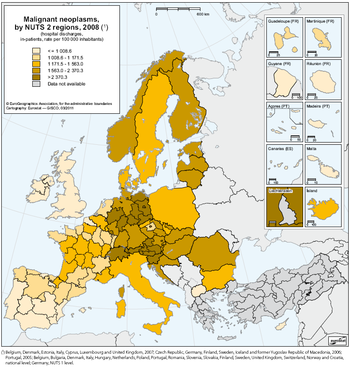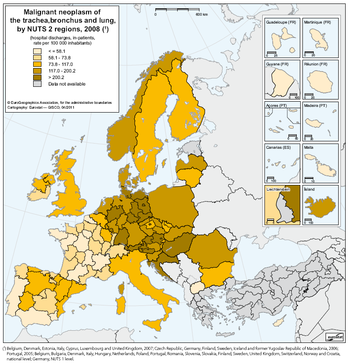Archive:Hospital discharge statistics at regional level
- Data from March 2011, most recent data: Further Eurostat information, Main tables and Database.

This article takes a look at mortality patterns in the European Union (EU), down to the regional level (NUTS 2). These vary significantly with age and gender, but also between countries and regions. Three types of factor determine mortality: intrinsic factors, such as age and gender; extrinsic factors, such as biological or collective social factors, living or working conditions; and individual factors, such as lifestyle, smoking, alcohol consumption, driving and sexual behaviour.
As a general rule, the mortality rate is higher among men than among women in all age groups. Although there are signs that the mortality gap is narrowing in some Member States, there are still significant differences between genders.
Main statistical findings


Regional data on hospital discharges of in-patients were not available until 2005 and not all countries are yet in a position to provide this data at subnational level.
Alongside information on the different ‘causes of death’, data on hospital discharges at national and regional levels are complementary means of estimating the frequency of treatment of some lethal diseases such as specific forms of malignant neoplasm.
On average, around 18 000 per 100 000 inhabitants and per country were discharged from hospitals in the EU-27 in 2008. However, that number hides a wide range of variations between countries, from 9 500 in Malta to over 27 500 in Austria.
A comparison of the number of in-patient discharges at NUTS level 2 indicates that regions in central Europe have the highest number of discharges per 100 000 inhabitants.
Malignant neoplasms of trachea, bronchus and lung
The above observation on central Europe also applies to combined malignant neoplasms of the trachea, bronchus and lung. In principle, the area stretching from Germany in the west to Romania in the east and from Croatia in the south to Denmark in the north has higher rates of in-patients per 100 000 inhabitants than other areas of the EU.
For the age group 70–74, Austria reports the highest figures (938 in-patient discharges per 100 000 inhabitants), with Hungary in second place (with 868) and Malta the lowest number (69). There is a similar pattern in the next age group (75–79), with Austria and Malta again recording the highest and lowest figures.
Out of the countries that provide regional data, Germany, the Czech Republic and, to a lesser degree, France show the greatest internal variability. In Bremen (Germany), 400 in-patients per 100 000 inhabitants were discharged, compared to barely 166 in Rheinland-Pfalz. Similarly, the ratio of Praha in the Czech Republic (205) is more than twice that in Strední Cechy. In France, the figures for Corse are very different from the mainland regions (121, twice the French average). The data for Germany and the Czech Republic are 2006 figures.
Breast cancer
Another major malignancy causing hospital stays and discharges is the gender-associated breast cancer. Again, the rates are highest in central Europe, followed by Finland and the Baltic States.
The population of women aged 40 to 44 can be considered as a ‘turning point’ for the risk of breast cancer. In all countries, this cohort is the first to record a high number of in-patient discharges. The same phenomenon is found at regional level. For this age group, Austria has the highest rate, with 485 per 100 000 inhabitants, Germany reports 352, and Malta has the lowest with 32.
Looking at the two age groups 70–74 and 75–79, once again Austria and Malta have the highest and lowest rates of all countries, just as they had for combined malignant neoplasms of the trachea, bronchus and lung. Austria recorded a rate of 1 164 discharges per 100 000 inhabitants for persons 70–74 years old, whilst the rate in Malta was only 101.
Germany and Austria also show important regional disparities when aggregating all female age groups. In Germany, Niedersachsen had a rate of 684 in-patient discharges per 100 000 inhabitants, but it was 1 229 in Schleswig-Holstein. In Austria, the difference is even bigger: as compared to Burgenland with only 626, Wien had a rate of 1919. Again, the data for Germany are from 2006.
Conclusion
Information on hospital discharges are a prerequisite for monitoring the performance of health policy.
Regional indicators provide an insight into similarities, particularities and differences across regions in Europe.
There can be big differences between regions in the same country, and regions in different countries may be very similar. A thorough analysis of trends and variations in health indicators at regional level is therefore essential to plan and monitor action and programmes, formulate new policies, develop new strategies and contribute to evidencebased health policymaking.
Eurostat’s work on health statistics mainly focuses on further improvements that are needed to make the current data more comparable and complete and to extend regional coverage.
Data sources and availability
Regional data on hospital discharges of in-patients were not available until 2005 and not all countries are yet in a position to provide this data at subnational level.
Alongside information on the different ‘causes of death’, data on hospital discharges at national and regional levels are complementary means of estimating the frequency of treatment of some lethal diseases such as specific forms of malignant neoplasm.
Context
Health is an important priority for Europeans, who expect to be protected against illness and disease at home, in the workplace and when travelling across the EU. Health issues cut across a range of topics — including consumer protection (food safety issues), safety at work and environmental and social policies — and thus have a considerable impact on the EU’s revised Lisbon strategy.
Member States generally have the responsibility for organising and delivering health services and healthcare. The EU has the responsibility to give added value by launching initiatives such as those on cross-border health threats and patient mobility, reducing health inequalities and addressing key health determinants. Gathering and assessing accurate, detailed information on health issues is vital for the EU to effectively design policies and target future action.
On 23 October 2007, the European Commission adopted a new strategy ‘Together for health: A strategic approach for the EU 2008–13’ to set objectives that will guide future work on health at European level. Within the European Commission, the strategy is supported by the ‘Second programme of community action in the field of health 2008–13’. This programme has been adopted with three broad objectives that align future act on on health more closely to the objectives of prosperity, solidarity and security, namely:
- improving citizens’ health security;
- promoting health to improve prosperity and solidarity;
- generating and disseminating health knowledge.
To monitor progress on these objectives, Regulation 1338/2008 of the European Parliament and of the Council on Community statistics on ‘public health and health and safety at work’ is the legal framework for compiling the required background statistics. It covers causes of death, health status, health determinants and healthcare.
Further Eurostat information
Publications
- Atlas on mortality in the European Union
- Eurostat regional yearbook 2011, chapter 5
- Eurostat regional yearbook 2010, chapter 12
- Who dies of what in Europe before the age of 65 - Statistics in Focus 67/2009
Main tables
- Health, see:
- Public health (t_hlth)
- Health care: resources and patients (non-expenditure data) (t_hlth_care)
- Discharges from hospitals (tps00048)
- Health care: resources and patients (non-expenditure data) (t_hlth_care)
Database
- Health, see:
- Public health (hlth)
- Health care activities (non-expenditure data) (hlth_act)
- Hospital patients (hlth_inpat)
- Health care activities (non-expenditure data) (hlth_act)
Dedicated section
- Health, see:
- Public health